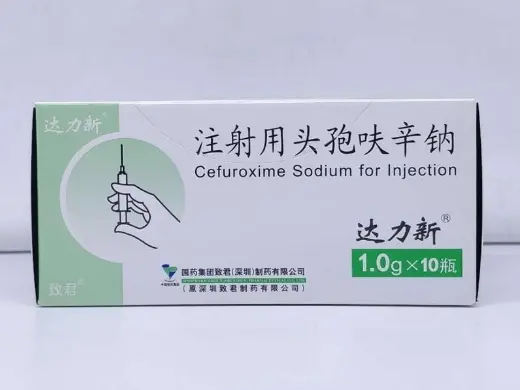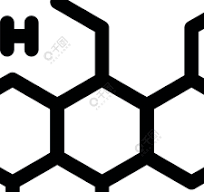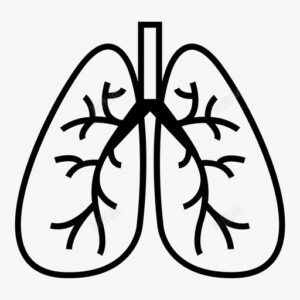Cefuroxime axetil
Effects and efficacy: Cefuroxime is suitable for the treatment of the following infections caused by sensitive bacteria: respiratory system and ear, nose and throat infections (such as pharyngitis, tonsillitis, otitis media, sinusitis, acute and chronic bronchitis, bronchiectasis and infection, bacterial pneumonia, lung abscess, postoperative lung infection, acute maxillary sinusitis); genitourinary system infections (such as pelvic inflammatory disease, pyelonephritis, cystitis, asymptomatic bacteriuria, gonorrhea); bone and joint infections (such as osteomyelitis and septic arthritis); skin and soft tissue infections (such as cellulitis, peritonitis, erysipelas, impetigo and trauma infection). It is also used to prevent surgical infections (such as abdominal pelvic and orthopedic surgery, heart, lung, esophageal and vascular surgery, total joint replacement surgery). It can be used to treat sepsis and meningitis; it is used for simple gonorrheal proctitis in women caused by non-penicillinase-producing Neisseria gonorrhoeae and early migratory erythema (Lyme disease) caused by Borrelia burgdorferi. Dosage and Administration:
The dosage and administration of this product may vary for different dosage forms and specifications. Please refer to the specific entry content or follow the doctor’s advice. The general usage is as follows: Oral administration, 0.25g once, twice a day, the general course of treatment is 5-10 days. Intramuscular injection, 0.75g once, once every 8 hours. If necessary, the dose can be increased to once every 6 hours under the guidance of a doctor, and the total daily dose is 3-6g. Intravenous injection and intravenous drip, 0.75g once, once every 8 hours. For more serious infections, it can be increased to 1.5g once, once every 8 hours. If necessary, the dose can be increased to once every 6 hours under the guidance of a doctor, and the total daily dose is 3-6g. Cefuroxime Axetil Granules/Cefuroxime Axetil Tablets/Cefuroxime Axetil Capsules: Oral medication. In severe infections or suspected pneumonia, 0.5g each time, twice a day; general urinary tract infections, 0.125g each time, twice a day; the recommended dose for patients with uncomplicated gonorrhea is 1g, taken as a single dose. Lyme disease: For adults and children over 12 years old, the recommended dose is 0.5g each time, twice a day, for 20 days. The general dosage for children is 0.125g each time, twice a day. For patients with otitis media under two years old, 0.125g each time, twice a day; for patients with otitis media over two years old, 0.25g each time, twice a day; for children over 12 years old, the dosage is the same as that for adults. For patients who have achieved a certain effect of injection of cefuroxime sodium and still need to continue treatment, this product can be changed to oral treatment. Elderly patients do not need to adjust the dose according to age factors. Cefuroxime axetil dry suspension/cefuroxime axetil dispersible tablets are taken orally. This product can be taken directly orally or stirred evenly in warm water before taking. In case of severe infection or suspected pneumonia, 0.5g each time, twice a day: for general urinary tract infection, 0.125g each time, twice a day, and the recommended dose for patients with uncomplicated gonorrhea is 1g, taken as a single dose. The general dosage for children is 0.125g each time, twice a day. For patients with otitis media under two years old, 0.125g each time, twice a day; for patients with otitis media over two years old, 0.25g each time, twice a day. For children over 12 years old, the dosage is the same as that for adults. Cefuroxime Sodium for Injection: It can be used for intravenous injection, intravenous drip or deep intramuscular injection. General or moderate infection: 0.75g once, 3 times a day, intramuscular or intravenous injection. Severe infection: double the dose, 1.5g once, 3 times a day, intravenous drip for 20-30 minutes. Infants and children are given 30-100mg/kg per day according to their body weight, divided into 3-4 doses. Note: Injection drug preparation intramuscular injection: 0.25g of Cefuroxime Sodium for Injection is added to 1ml of water for injection, or 0.75g of Cefuroxime Sodium for Injection is added to 3ml of water for injection, and gently shaken to make an opaque suspension. Intravenous injection: 0.25g of cefuroxime sodium for injection is added with at least 2ml of water for injection, or 0.75g of cefuroxime sodium for injection is added with at least 6ml of water for injection to dissolve into a yellow clear solution. Intravenous drip: 1.5g of cefuroxime sodium for injection can be dissolved in 50ml of water for injection or combined with most commonly used intravenous injection solutions (except aminoglycosides).
Adverse reactions:
Adverse reactions such as abdominal pain, diarrhea, nausea, vomiting, decreased appetite, oral ulcers, rash, erythema, itching and headache may occur after medication. In addition. Overdose may also cause brain stimulation and lead to convulsions. There are reports of pseudomembranous colitis after medication. If you have persistent or severe diarrhea, or abdominal cramps, please seek medical attention in time. The main adverse reactions of oral preparations of cefuroxime axetil include digestive system reactions (such as abdominal pain, diarrhea, nausea, vomiting, decreased appetite, oral ulcers, etc.), skin reactions (such as rash, erythema, itching) and headaches. Rare adverse reactions include: Allergic reactions: including allergic reactions, angioedema, pruritus, rash, drug-induced fever, serum sickness-like reactions and urticaria. Gastrointestinal reactions: pseudomembranous colitis and liver damage (including hepatitis, cholestasis and jaundice). Hematological examination: hemolytic anemia, leukopenia, pancytopenia and thrombocytopenia. Skin: erythema multiforme, Stevens-Johnson syndrome, toxic epidermal necrolysis (eruptive epidermal necrolysis). Urinary system: renal impairment, etc. Others: In addition to the adverse reactions observed in patients treated with cefuroxime axetil listed above, the following adverse reactions and laboratory changes have been seen in patients treated with cephalosporins: reports of eosinophilia and transient elevations of ALT, AST and LDH. Like other cephalosporins, reports of jaundice are rare. There have been reports of positive Coombs’ test reactions during cephalosporin treatment, which can interfere with blood cross-matching. Renal insufficiency, toxic nephropathy, hepatobiliary stasis, aplastic anemia, hemolytic anemia, bleeding, prolonged coagulation time, elevated BUN, elevated inosine, elevated alkaline phosphatase, neutropenia, thrombocytopenia, leukopenia, elevated bilirubin, pancytopenia and agranulocytosis, etc. Cefuroxime sodium injection occasionally causes rash and elevated serum aminotransferase, which disappear after discontinuation of the drug. There is a cross-allergic reaction with penicillin. According to literature reports, long-term use of this product can lead to the proliferation of non-sensitive bacteria and gastrointestinal disorders, including pseudomembranous colitis, which rarely occurs in the middle and late stages of treatment. Rare transient decreases in hemoglobin concentration, eosinophilia, and leukocytopenia and neutrophil reductions occur, which disappear after discontinuation of the drug. When injected intramuscularly, there will be temporary pain at the injection site, especially when the dose is large.
Drug contraindications:
Contraindicated for allergic reactions to this product
Share:
Products
Our offers
Health Classification
Let us work together to protect precious health






























